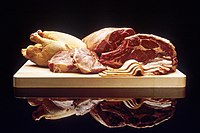
Photo from wikipedia
With the rapid development of the edible fungi industry in the world, especially in China, the resource utilization of edible fungi by-products has become an urgent problem for the industry's… Click to show full abstract
With the rapid development of the edible fungi industry in the world, especially in China, the resource utilization of edible fungi by-products has become an urgent problem for the industry's sustainable development. The waste residue of edible fungi after polysaccharide extraction by water accounts for a large proportion, which contains a large amount of water-insoluble dietary fiber (IDF). At present, the extracted residue is generally treated as fertilizer or solid waste, which not only pollutes the environment, but wastes resources too. In order to develop these by-products, expand their potential utilization in the food industry, the structure characterization, physicochemical properties, and the influence of IDF on dietary energy intake were studied. The IDF from the residues of polysaccharides extracted from four edible fungi was extracted using the Association of Official Analytical Chemists (AOAC) method. The results showed that IDF in the four kinds of edible fungi residues was similar in composition but different in texture. Cellulose and hemicellulose are the main IDF extracted from four kinds of edible fungi. Among them, Hericium erinaceus is the softest without obvious granular texture, following Lentinus edodes, while Ganoderma lucidum and Grifola frondosa have a relatively hard texture. The yield of four kinds of IDF from high to low came from Ganoderma lucidum, Hericium erinaceus, Lentinus edodes, and Grifola frondosa. Fourier transform IR (FTIR) and X-ray diffraction (XRD) spectra showed that the four IDFs had similar functional groups and all of them contained a large amount of cellulose. Physical and chemical analysis showed that all the four IDFs had certain water holding capacity, water binding capacity, and oil holding capacity. In-vitro digestion experiments showed that the four IDFs could inhibit the digestion of starch and fat to a certain extent. By-products of edible fungi are an ideal material for the recovery of IDFs, which have the potential to be processed into functional food materials due to their physicochemical properties and physiological functions.
Journal Title: Frontiers in Nutrition
Year Published: 2022
Link to full text (if available)
Share on Social Media: Sign Up to like & get
recommendations!